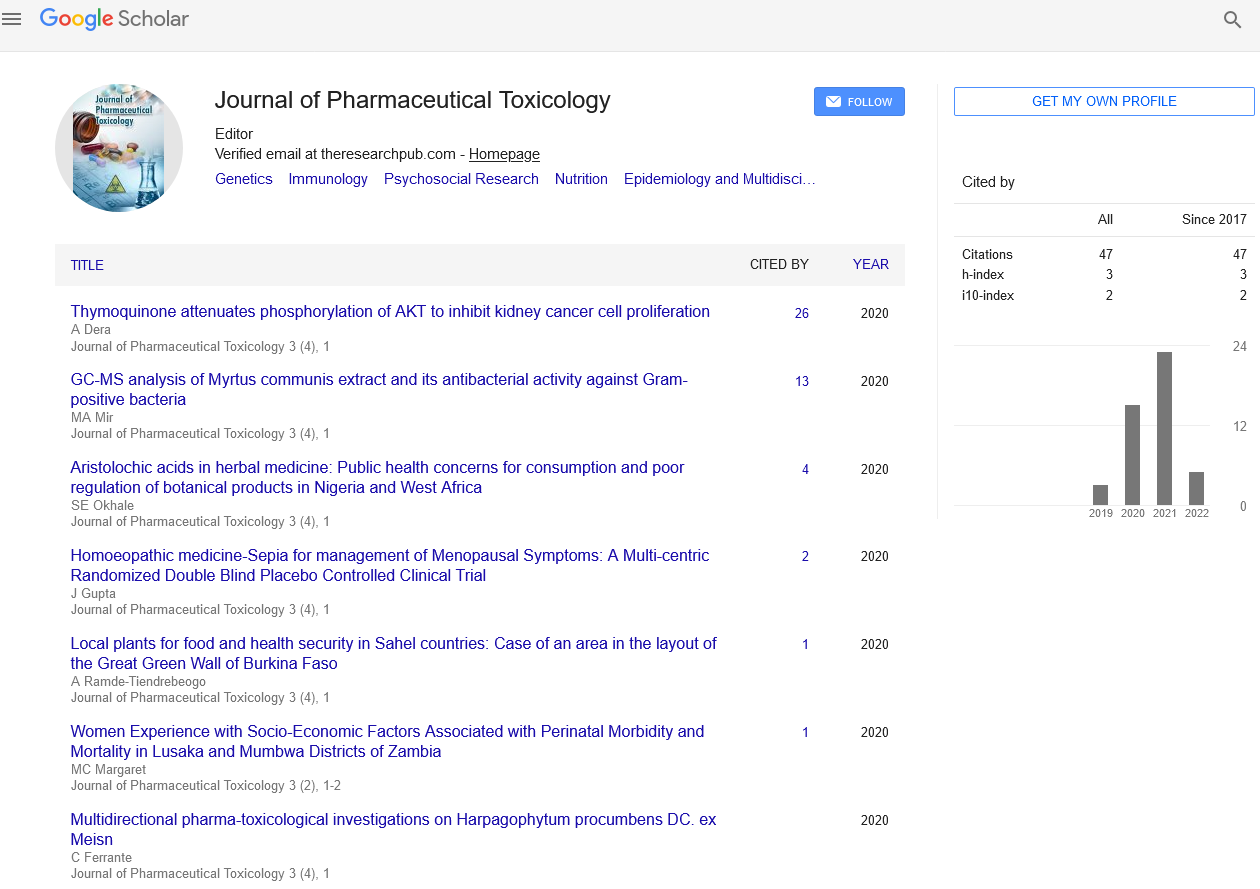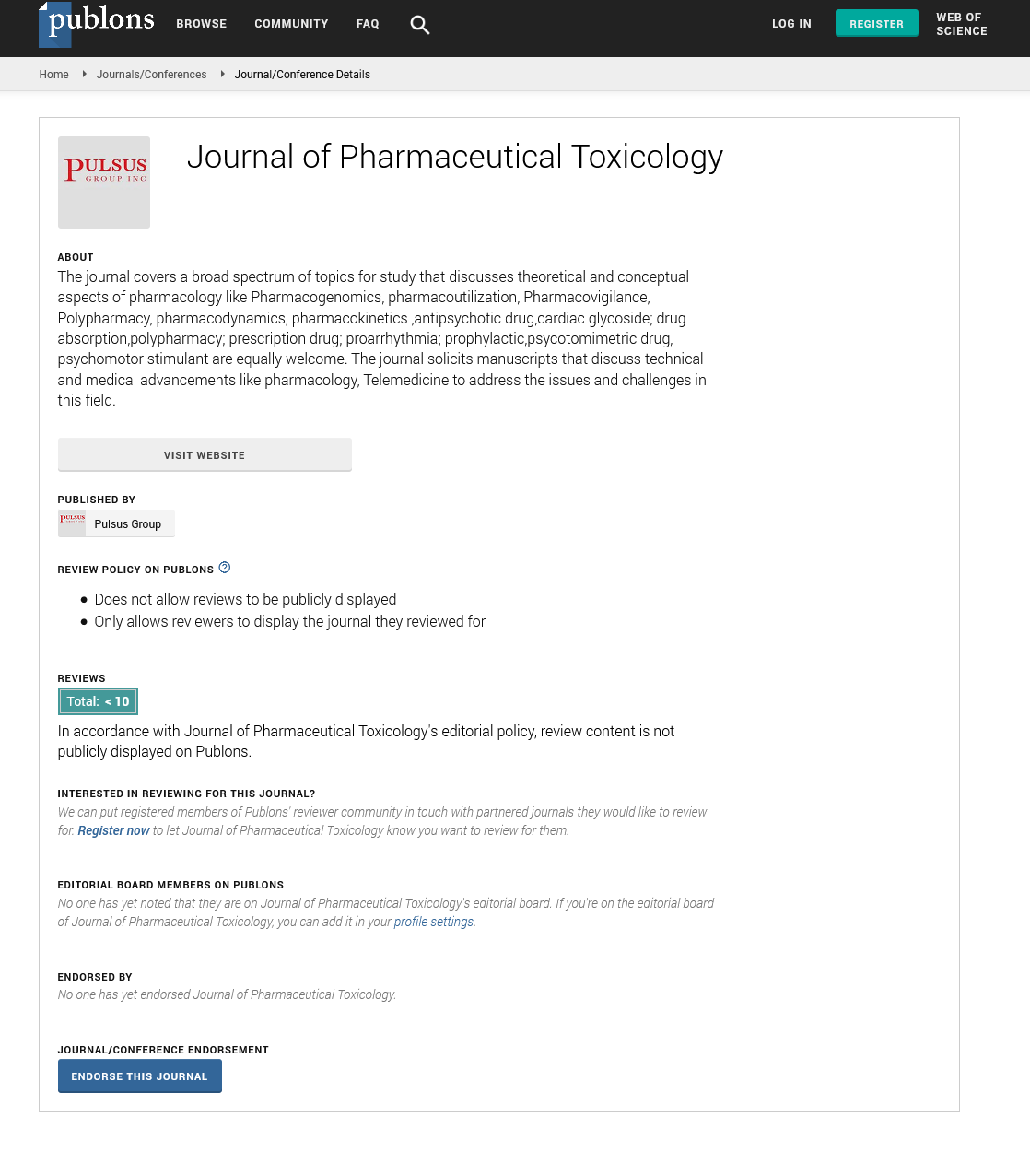Commentary - Journal of Pharmaceutical Toxicology (2022) Volume 5, Issue 3
The Economic Value of Wetlands in Urban Areas
Liya Sierra*
Department of Economics, Pontificia Universidad Javeriana de Cali, Cali 760031, Colombia
Received: 02-Jun-2022, Manuscript No. jpt-22-29850; Editor assigned: 06-Jun-2022, PreQC No. jpt-22-29850 (PQ); Reviewed: 20-Jun-2022, QC No. jpt-22-29850; Revised: 23-Jun- 2022, Manuscript No. jpt-22-29850 (R); Published: 30-Jun-2022, DOI: 10.37532/jpt.2022.5(3).52-54
Abstract
Urban growth has impacted natural ecosystems such as wetlands. This situation destabilizes the beneficial contributions of nature, generating a socioeconomic effect. There is a need to quantify the benefits of wetlands in developing countries and urban areas, where the growth of cities is fastest. This is the first valuation study of urban and peri-urban wetlands in Colombia. The methodology includes a benefit transfer (BT) method with a geographical information system (GIS) and an exploratory governance analysis. Because there are few studies on the economic valuation of urban wetlands in Latin America, we present a methodology of interest, which can be easily replicated in other cities of this subcontinent. Based on an economic approach, our results find that 76% of the total value of wetlands is provided by ecosystem services (ES) of existence and legacy value, followed by maintenance of the life cycle of migratory species and water supply. Urban areas are identified where users benefit more than areas where the population exerts greater pressure on wetlands.
Keywords
wetlands• urban ecosystem services• valuation• benefit transfer
Introduction
Wetland systems support human livelihoods and are critical to sustainable development. Despite this, 50% of the total area of wetlands in the world has been lost because of agricultural activities, cattle ranching, mining, the growth of cities, and other human actions. As a result of the degradation of wetlands in Colombia, the floods that occurred between 2010 and 2011 affected 31% of the country, generating considerable economic losses. In the Cauca River Valley, 88% of the wetlands were lost, mainly because of drainage activities, land reclamation, river-channel regulation, and pollution. The city of Cali has 61 wetlands within its urban area and 175 peri-urban wetlands, which have been affected by change of use and a deterioration of their ecosystem. As in other regions and countries, the pursuit of short-run human wellbeing has been detrimental to biodiversity. With the deterioration of the wetlands in Cali, some ecosystem services (ES) have been lost (e.g., carbon sequestration—thus increasing greenhouse gases) [1]. This situation must be quantified because it means that the loss or gain of values will ultimately be reflected in society. Therefore, if the value of the benefits provided by nature is understood, we can move closer to the development of sustainable cities. From an institutional perspective, it has been suggested that natural resources should be understood as common-pool resources. In other words, they are rivalrous in terms of consumption because natural resources become depleted. Nor can they be excluded because they are freely accessible to people. There is a need to develop institutional rules within social-ecological systems that allow the development of institutions that achieve optimum levels of cooperation from stakeholders.
Materials and Methods
Spatial definition of the study area First, we worked with the files of the wetland inventory maps provided by the Administrative Department of Environmental Management of Cali (DAGMA) and Spatial Data Infrastructure of Cali (IDESC). Next, the data were obtained in the R programming language with the assigned attributes in terms of wetland type (urban or periurban), name, location, and area. Then we proceeded to superimpose the maps of the urban perimeter, comunas (a group of neighborhoods within a city), corregimientos (a territorial area, the jurisdiction of which depends on the municipality), rivers, streams, and wetlands to define the study area set out in Section [2]. : Obtaining data from original research studies. The classification is used as a reference to obtain the estimates of ES values of the study site. To obtain values from studies with similar characteristics to the policy site, the ESVD was filtered in terms of geographic coordinates, selecting those studies located within 23◦ north latitude and 23◦ south latitude (Tropical zone between the Tropic of Cancer triangle and Tropic of Capricorn triangle to which the Cali wetlands belong). Next, those values obtained through primary research were selected. Those corresponding to inland wetlands with local study scale located in developing countries were also selected. Moreover, aboveground and belowground carbon stock indicators from Dayathilak et al [3].
Discussion
Shows the average value per ES of wetlands: developing countries, 236–6620 USD/ha/ year/ES; developed countries, 2942–7403 USD/ha/year/ES; and global 2279 USD/ha/ year/ES. On one hand, the meta-regressions by He et al and Chaikum bung et al. Show that the value of wetlands in developing countries is lower than in developed countries. This can reflect findings that explain that the value of wetlands is influenced by the level of development of the country, showing a higher value in those countries with higher GDP. On the other hand, in developing countries, the valuation of peri-urban wetlands in Cali presents values lower than those obtained by Ibarra et al [4]. In Mexico City for the urban wetland of Xochimilco this can be explained by the fact that evidence has been found where urban wetlands have a higher value than rural wetlands. This is due to urban residents having higher incomes than rural inhabitants, in addition to having different preferences. Citizens with higher incomes are also more willing to pay to protect wetlands. Furthermore, the valuation of urban wetlands in Cali presents values that are higher than Ibarra et al. This can be understood by the findings in the literature that show a negative relationship between wetland value per hectare and wetland area.
Conclusions
Using benefit transfer and supported by data provided by GIS, this study carried out a total valuation of 61 urban wetlands and 175 peri-urban wetlands in Cali, covering an area of 250 ha. The wetlands are part of the environmental influence area that provides ES to the city, benefiting the population, businesses, and institutions. The total annual value of wetlands in Cali is estimated as USD 8,643,583. Seventy-six percent of the total value of the wetlands is provided by the ES for existence and legacy value, maintenance of the life cycles of migratory species, and water supply [5]. The per capita value of wetlands depends on the distribution of the population in the comunas and corregimientor of the city. The economic valuation is an approximate estimate that provides information on the benefits of wetlands, thus being a better alternative to not recognizing any value of these ecosystems.
Results
The benefit transfer method allowed us to obtain the mean for 11 ES and 94 value estimates, whose description was taken from TEEB present the results of the Cali urban and peri-urban wetland valuation, which is USD 8,643,583. On one hand, the total value of urban wetlands is USD 2,388,942 (72,825 USD/ha/year). On the other hand, the total value of peri-urban wetlands is USD 6,254,641 (28,773 USD/ha/year). Urban and peri-urban wetland valuations represent 28% and 72% of total value, respectively. The lower proportion of the value of the former is a consequence of their smaller quantity and extension. The highest valuations obtained are those of existence and legacy value (40%), maintenance of the life cycle of migratory species (23%), and water supply (13%). The first results can be understood as the heritage of future generations. In line with this, the land-use plan of Cali includes wetlands as conservation and environmental protection areas [6]. The second findings can be interpreted as the evidence of having shelter for animals.
Acknowledgement
None
Conflict of Interest
No conflict of interest
References
- Ricaurte L F, Olaya Rodríguez M H, Cepeda Valencia J, Lara D, Arroyave Suárez J, Finlayson C M Palomo I et al. Future impacts of drivers of change on wetland ecosystem services in Colombia. Glob Environ Chang. 44, 158–169(2017).
- Wang C, Wang Y, Wang R, Zheng P et al. Modeling and evaluating land-use/land-cover change for urban planning and sustainability : A case study of Dongying city, China J, Clean, Prod.172, 1529–1534(2018).
- Filho W L, Barbir J, Sima M, Kalbus A, Nagy G J, Paletta A, Villamizar A, Martinez R, Azeiteiro U M, Pereira M J, et al. Reviewing the role of ecosystems services in the sustainability of the urban environment. A multi-country analysis. J. Clean. Prod. 262, 121-338(2020).
- Hu S, Niu Z, Chen Y, Li L, Zhang H et al. Global wetlands: Potential distribution, wetland loss, and status. Sci. Total Environ. 586, 319–327(2017).
- Sierra L, Marin W, Castro L, Hernández Manrique O et al. Economic Valuation of Benefits in Freshwater Ecosystems: Complex Wetlands System Belonging to the San Juan River in the Magdalena, Medio Region, Colombia. Sustainability, 13, 5374 (2021).
- Haase D, Larondelle N, Andersson E, Artmann M, Borgström S, Breuste J, Gomez Baggethun E, Gren A, Hamstead Z, Hansen R et al. A Quantitative Review of Urban Ecosystem Service Assessments: Concepts, Models, and Implementation. Ambio, 43, 413–433(2014).
Indexed at, Google Scholar, Crossref
Indexed at, Google Scholar, Crossref
Indexed at, Google Scholar, Crossref
Indexed at, Google Scholar, Crossref
Indexed at, Google Scholar, Crossref


